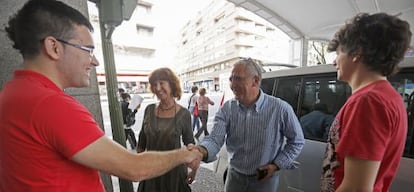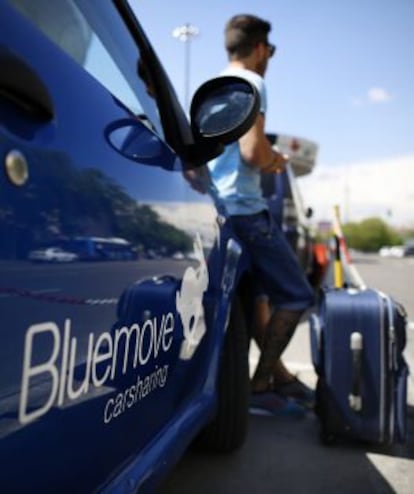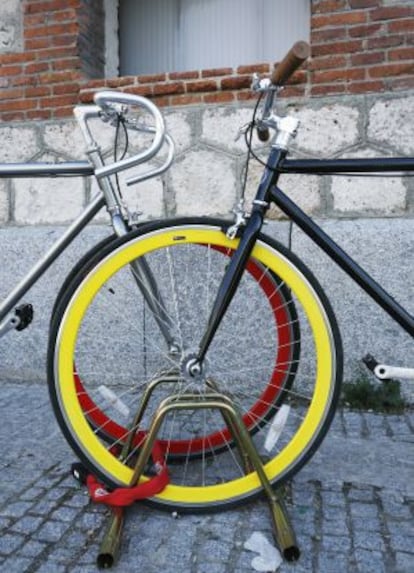Smarter, cheaper and greener ways to get around town
From car sharing to power walking, there have never been more methods of mobility Mobile technology is making it easier to access new alternative means of transport in Spain’s cities


Ever-more costly gasoline, gridlocked traffic, global warming and, above all, the need to save money are just a few of the harsh realities facing the Spanish automobile sector, which is going through its worst slump since 1986. Young people are no longer interested in owning a car, especially if they live in a large city.
But that, of course, doesn’t mean they still don’t need to get around. One answer could be car sharing. BlaBlaCar is one of the most popular car-sharing sites in Europe. The company has grown three times faster in Spain than it has in the other 12 countries in which it operates.
Vincent Rosso, BlaBlaCar’s co-founder and director in Spain, says 85 percent of its customers use the site to save money. “The crisis has changed the way people think,” he says. The company’s formula is simple: the price of a journey – gasoline and tolls – is divided between the passengers. The most popular route, between Madrid and Valencia, costs around €17, €9 less than by bus.
The company says its customers see traveling as a way to get to meet people, and put particular emphasis on the reduced environmental impact of sharing a journey. BlaBlaCar estimates that over the course of its five years in business, it has reduced CO2 output by 700,000 tonnes.

Another new phenomenon in Spain is car rentals by the hour, and Bluemove is the country’s pioneer. The firm says it has grown threefold since 2012. It offers drivers access to a vehicle in a number of central locations in Madrid. Customers sign up via a website, and are then sent a swipe card. They can then reserve through the site.
“The saving comes from more efficient use of the car,” says Jorge González-Iglesias, Bluemove’s co-founder. “The vehicle becomes a service rather than a piece of property, which means people are more responsible when using it. You think more about the journey you are going to take, and choose the best means of transport. Sometimes this can be a car, but other times it can be public transport.” He says that each Bluemove car means 15 fewer privately owned vehicles on the road.
There are around 120 pickup and dropoff points in Madrid, making Bluemove highly accessible. Users download a GPS app that tells them where the nearest vehicle is. “It feels more like using your own car than renting,” says González-Iglesias.
Bluemove’s latest venture lets residents of a particular area acquire a vehicle with the technology that allows it to be shared already installed. Picking one up can be done quickly thanks to a smartphone app, with no need for keys. Users pay between €50 and €150 each per month, depending on how much they use it.
Another way of sharing costs and reducing emissions is through the JoinUp Taxi service, created by Alberto López and Elena Peyró. “We thought the most intelligent way to move around a big city is jointly,” says López. They launched the application 18 months ago, and are now present in most of Spain’s major cities. More than 1,000 taxis have signed up, and around 17,000 people have downloaded the app. Young people in particular use the service because they find it fun, says López: “Once you’ve tried it you’ll use the service again; it’s particularly useful for journeys to train stations and airports.”
Madrid City Hall has finally decided to offer its own rental bikes, a service that will be available from June. In the meantime, companies such as Mobeo have filled the gap. “We are a showroom for bikes designed for urban transport,” says Álvaro Ventura, one of the company’s founders.

As well as renting bikes by the hour, day, or week, Mobeo also advises buyers on what kind of two-wheeled transport best suits them, depending on where they live, if they have a lift, how often they use the bike, or whether comfort is a factor. “People buy heavy bikes with lots of accessories that just make them more likely to be stolen. We offer people what they really need,” says Ventura.
The most popular models are folding bikes, which are easy to take on the bus or metro. Mobeo recommends people combine biking with public transport. It also sells electric bikes: around 60 percent of its customers are aged over 65.
Anybody who has sat on a bus or hung on to a strap during a seemingly interminable Metro journey to and from work may well have wondered if they might not have been better off walking. Ephimera is an association that offers advice on how to cover short inner-city journeys quickly on foot, or by what has become known as power walking. “In the center of town, most routes can be covered by walking in the same time it takes on the metro,” says Ephimera’s María Álvarez.
She adds that not only is power walking the cheapest way to get around, it also keeps you fit, and allows you to get to know parts of the city you may not know, or have never taken the time to get to know. “Walking changes the way you think,” says Álvarez.
Tu suscripción se está usando en otro dispositivo
¿Quieres añadir otro usuario a tu suscripción?
Si continúas leyendo en este dispositivo, no se podrá leer en el otro.
FlechaTu suscripción se está usando en otro dispositivo y solo puedes acceder a EL PAÍS desde un dispositivo a la vez.
Si quieres compartir tu cuenta, cambia tu suscripción a la modalidad Premium, así podrás añadir otro usuario. Cada uno accederá con su propia cuenta de email, lo que os permitirá personalizar vuestra experiencia en EL PAÍS.
¿Tienes una suscripción de empresa? Accede aquí para contratar más cuentas.
En el caso de no saber quién está usando tu cuenta, te recomendamos cambiar tu contraseña aquí.
Si decides continuar compartiendo tu cuenta, este mensaje se mostrará en tu dispositivo y en el de la otra persona que está usando tu cuenta de forma indefinida, afectando a tu experiencia de lectura. Puedes consultar aquí los términos y condiciones de la suscripción digital.
Últimas noticias
Pinochet’s victims grapple with José Antonio Kast’s rise in Chile
Reinhard Genzel, Nobel laureate in physics: ‘One-minute videos will never give you the truth’
How Japan is trying to avert ‘digital defeat’
The complicated life of Francesca Albanese: A rising figure in Italy but barred from every bank by Trump’s sanctions
Most viewed
- Pablo Escobar’s hippos: A serious environmental problem, 40 years on
- Why we lost the habit of sleeping in two segments and how that changed our sense of time
- Charles Dubouloz, mountaineering star, retires at 36 with a farewell tour inspired by Walter Bonatti
- Trump’s obsession with putting his name on everything is unprecedented in the United States
- The Florida Keys tourist paradise is besieged by immigration agents: ‘We’ve never seen anything like this’








































